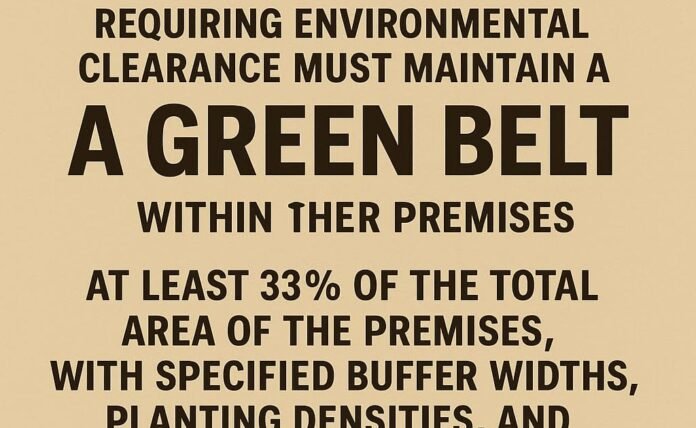[ad_1]
In a move to mitigate environmental degradation and promote sustainable industrial growth, the Government of India introduced the Environment Impact Assessment (EIA) Notification, 2006. One of the most significant provisions under this notification is the mandatory development and maintenance of a green belt by industrial units, including factories.
📜 Legal Basis: EIA Notification 2006
Issued under the Environment (Protection) Act, 1986, the EIA Notification S.O. 1533(E), dated 14 September 2006, lays down the framework for obtaining Environmental Clearance (EC) before setting up or expanding certain types of industrial projects. A key environmental safeguard included in EC conditions is the green belt requirement.
—
🌳 What is a Green Belt?
A green belt is a buffer zone with dense vegetation—trees, shrubs, and grass—planted around and within the premises of industrial units. It serves to:
- Absorb air and noise pollution
- Act as a natural dust and gas barrier
- Improve ambient environmental quality
- Enhance aesthetics and biodiversity
—
🏭 Who is Required to Maintain a Green Belt?
All industrial projects falling under the scope of EIA Notification 2006—such as manufacturing units, chemical plants, thermal power plants, and other polluting activities—are required to:
Obtain Environmental Clearance (EC) from the Ministry of Environment, Forest and Climate Change (MoEFCC) or the State Environment Impact Assessment Authority (SEIAA)
Comply with the green belt condition listed in the EC document
—
📐 Green Belt Guidelines as per EC Conditions
As per various CPCB and MoEFCC guidelines, and EC conditions typically issued, factories must:
- ✅ Allocate at least 33% of the total area of the project site for green belt
- ✅ Ensure a minimum width of 5 to 10 meters for boundary plantations
- ✅ Adopt a three-tier plantation system in high-pollution industries
- ✅ Use native or pollution-tolerant tree species
- ✅ Achieve tree density of around 1,500 to 2,500 trees per hectare
- ✅ Maintain a minimum 80% plant survival rate
—
📌 Special Cases
Red Category Industries (e.g., hazardous chemical units, thermal plants) may be required to maintain wider buffer zones with stricter plantation norms.
In eco-sensitive zones and urban areas, the requirement may be more stringent or customized by local environmental authorities.
—
🛑 Penalty for Non-Compliance
- Non-compliance with green belt obligations under the EC conditions may lead to:
- Suspension or revocation of Environmental Clearance
- Fines under the Environment (Protection) Act, 1986
- Rejection of Consent to Operate by the State Pollution Control Board
—
✅ Best Practices for Compliance
- Engage environmental consultants to plan green belt layout during the project planning stage
- Use GIS tools to monitor green cover over time
- Conduct periodic plantation drives and survival audits
- Maintain records and photographs to demonstrate compliance
—
🔚 Conclusion
The green belt requirement is not merely a compliance formality—it is a critical step toward responsible industrialization. Factory owners and project developers must treat this obligation as a strategic investment in environmental protection and sustainable operations.
For updates and templates on EC conditions, green belt design, and factory compliance, stay tuned to Compliance Monk.
Gazette Copy – https://drive.google.com/drive/folders/1kdJ9uCnzAQBtIYp5UXdqgK3-HDvebxiV
[ad_2]
Source link



